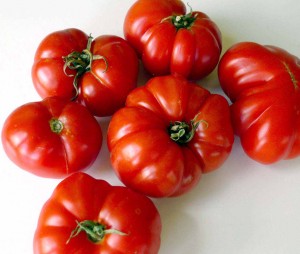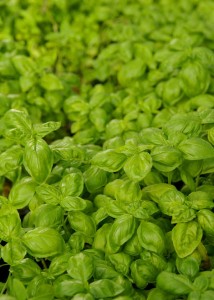It’s August and we are eating insalata caprese for lunch every day in a vain attempt to keep up with the tomatoes and basil from the garden. And we have the Ligurians to thank.
On my first visit to Genoa and the Ligurian coast in September 2005, I had the superb luck of eating lunch with researchers at the agricultural experiment station in Albenga, just west of Genoa. In true Italian style, our “casual” lunch consisted of several dishes in rapid succession, all of them featuring plants that the experiment station grows. That’s where I met my first Costuluto Genovese and Cuor di Bue Ligure tomatoes. The latter is a large pear-shaped tomato that the experiment station perfected in the 1950s from an heirloom variety that was more variable in its fruit shape and size. The oxheart is now one of the most important market tomatoes of Liguria, and it’s a tasty late-season producer.

But my heart (and tastebuds) were taken with the deeply pleated “ugly” variety known as Costuluto Genovese, which has a rich tomato flavor. Moreover, its slices have pleasingly frilly edges. Fortunately, it’s a rather thin-skinned tomato, so the skins slip right off after a 10-second dip in boiling water.
Arable land along the Ligurian coast comes at a substantial premium — roughly $400,000 per acre – so farmers tend to concentrate on high-value crops. They grow tomatoes because they love the flavor, but they grow flowers because the payback is so substantial. Flowers and basil.
 Genovese basil is justly famous worldwide, and the Albenga station invests a great deal of research effort to selecting substrains that are even more aromatic than the original. This picture shows a flat of seedlings growing at the station. When I was leaving, one of the researchers presented me with a small envelope of maybe 10,000 seeds so I could grow my own.
Genovese basil is justly famous worldwide, and the Albenga station invests a great deal of research effort to selecting substrains that are even more aromatic than the original. This picture shows a flat of seedlings growing at the station. When I was leaving, one of the researchers presented me with a small envelope of maybe 10,000 seeds so I could grow my own.
Alas, I lost the strain a few years ago when my community garden was torn up by the city of Cambridge, and I never did get to try growing the Ligurian tomatoes — until this year. An Italian chef told me about Seeds from Italy (growitalian.com), a Winchester, Mass., company that is the U.S. distributor for Franchi Sementi, an Italian seed company that’s been around since 1783. Franchi, it turns out, carries the seed for the Albenga versions of Genovese basil and Costuluto Genovese tomatoes.

I started the basil indoors in the first of March, the Costuluto tomatoes two weeks later. Both went into my 6′ by 12′ city garden in Cambridge on May 5 (the traditional last frost date). The basil was stressed by a few weeks of nights in the 40s, but rebounded quickly. We made our first batch of pesto around Memorial Day and will continue into October.
The tomatoes grew vigorously (Costulutos are indeterminate) and began to set fruit in mid-June. We harvested the first fruit on July 15, and we’re still harvesting three weeks later. Those tomato vines will finish soon after yielding about 20 pounds per plant. With the aid of a couple of local makers of fresh mozzarella and the tins of olive oil we toted home from Spain, we’ll be feasting on insalata caprese for at least a few more weeks.
